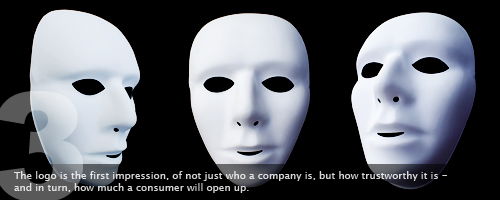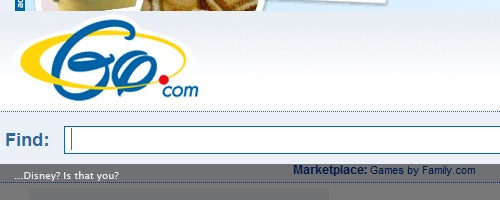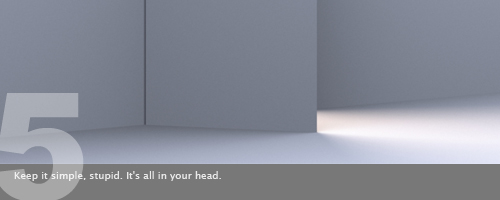- Home
- Blog
- Web Design 5 Branding Basics Every Logo Designer Should Know
5 Branding Basics Every Logo Designer Should Know
-
 10 min. read
10 min. read
-
 William Craig
William Craig CEO & Co-Founder
CEO & Co-Founder
- President of WebFX. Bill has over 25 years of experience in the Internet marketing industry specializing in SEO, UX, information architecture, marketing automation and more. William’s background in scientific computing and education from Shippensburg and MIT provided the foundation for MarketingCloudFX and other key research and development projects at WebFX.
While many articles try to dissect the process of designing a logo itself, I will attempt to share tips from my experiences with branding-focused logo design for the real world.  Photo by lpwines With the surge of “stock” logos, the quality of branding for new companies is literally going downhill. Many new designers fail to see that a logo, unlike any other design element, is literally the face of a company, and hence attached to a much larger beast.
Photo by lpwines With the surge of “stock” logos, the quality of branding for new companies is literally going downhill. Many new designers fail to see that a logo, unlike any other design element, is literally the face of a company, and hence attached to a much larger beast.
You can’t peel it off from a book and slap it onto things like a sticker.
A logo versus a brand
Let’s begin with the fine difference between a logo and a brand:
Logo
“The logo (ideogram), is the image embodying an organization. […] Logos are meant to represent companies’ brands or corporate identities […]”
– Logo as defined by Wikipedia
Brand and identity
“[A] burning scar [with] bankable value”
– From BusinessWeek
1. Research, research, research…
 Research is everything. It’s your first and last name, as well as your food and bed, when you are creating a brand. Research is the most important part of designing a logo, and branding as a whole.
Research is everything. It’s your first and last name, as well as your food and bed, when you are creating a brand. Research is the most important part of designing a logo, and branding as a whole.
Logo design with strong branding focus can easily push the limits of a five-figure budget primarily due to extensive research. Whether you are a solo freelancer or part of a branding team, your client’s target audience will heavily influence the decisions you make and the direction your design goes towards. Understanding a company’s marketing strategy is as important as placing the keystone in a building foundation.
Research encompasses everything from typography selection to presenting to a focus group.
2. A strong name is recognizable
 Photo by Stuart Chalmers Giving an identity a name and then giving the name a face. These are your bottom line goals when planning out your design. In that order.
Photo by Stuart Chalmers Giving an identity a name and then giving the name a face. These are your bottom line goals when planning out your design. In that order.
A strong name, with or without a mark, has to be recognizable without any taglines. It must carry weight of its own. For the life of me, no one can remember my last name, much less how to pronounce it (it’s Mekkaoui by the way).
But, say for example, I had you write it and pointed out that it included all the vowels in the alphabet, then you might remember me next time you come across it. In branding however, we don’t have that luxury. I would have to be able to catch your attention as you zipped down the supermarket aisle.
Hence, I made a short, rare name that I identify myself with and use persistently all over the web: Imokon. When Coca-Cola briefly changed their formula in 1985, people flipped over sabotaged history. Can you imagine their reaction if Coca-Cola changed their name to Sanscoca Fizzola?
Exactly. Coming up with a strong name can either be fun or a complete burden. Regardless of whether it’s made up (Skype), a misspelling (Google), or a simple word (Borders, Apple); it all goes back to marketing strategy.
You can read more about brand name types here.
3. A good logo builds trust
 The logo is the first impression, of not just who a company is, but how trustworthy it is – and in turn, how much a consumer will open up. Let’s say you point your browser to go.com.
The logo is the first impression, of not just who a company is, but how trustworthy it is – and in turn, how much a consumer will open up. Let’s say you point your browser to go.com.  It is very probable that one of three thoughts will go through your mind:
It is very probable that one of three thoughts will go through your mind:
- This place has a crappy Disney-esque logo.
- Is this a Disney company too?
- What’s the point?
…to which I’ll answer: the first two possible answers are exactly what I mean about “face”. That bubbly calligraphy used in the signature Walt Disney logotype is so well branded that the word “Disney” is all that you would think of. This is the difference between “This is a trustworthy site because it’s obviously Disney’s” or “This is a spam site and they couldn’t have made it more obvious”.
4. A good logo is distinctive and unique
 Photo by pshutterbug A strong logo, like a handsome face, does not tell you what’s inside; rather, it is a strong distinction amongst the masses, despite impersonation. Another way to look at it is:
Photo by pshutterbug A strong logo, like a handsome face, does not tell you what’s inside; rather, it is a strong distinction amongst the masses, despite impersonation. Another way to look at it is:  So…
So…
- You probably didn’t read the word cup in the second logo. Your eye stopped at “Coffee”.
- The first three, especially if rendered in grayscale, look very similar.The green caught your eye more than all the brown.
- You blinked at the Starbucks logo because it wasn’t really a Starbucks logo … but you still heard Starbucks in your head.
The creativity in designing a logo is not focusing on the subliminal—or the art—it’s in making an impact. The subtle hints (like the FedEx arrow for example) come naturally after the fact.
5. Details can make or break your design
 Now that we got the big items out of the way, let’s focus on the nitty-gritty stuff. You can waste a lot of time going back and forth with ideas, but in the end, simplicity is always a win-win solution. If you’ve never applied the KISS principle (keep it simple, stupid), you can be rest assured that you will in your logo project.
Now that we got the big items out of the way, let’s focus on the nitty-gritty stuff. You can waste a lot of time going back and forth with ideas, but in the end, simplicity is always a win-win solution. If you’ve never applied the KISS principle (keep it simple, stupid), you can be rest assured that you will in your logo project.
Typography:
If you have it made as a branding firm, you will have a very experienced typography expert on your team. If not, you’re still not completely out of luck. Reflecting back on the client’s target market – you’ll want to see what kind of fonts are common in that industry and what fonts are used by top competitors.
Hint: one of the best ways to do this is looking at movie posters and magazine covers. For example, the Bank Gothic typeface is mainly seen in action or sci-fi movies like X-men Origins: Wolverine or Hancock, but it’s been used in bad taste in Chipotle and Capital One Bank buildings. Now the ITC Avant Garde Gothic typeface is almost a default fashion industry standard.
Yet, I’ve seen Bank Gothic font used for a designer swimwear brand. Go figure – the fact that it was active clothing in nature might have made all the difference. For a more “antique” impression, many go with Trajan Pro, which traces back to ancient Roman columns and works wonders anywhere from Micheal Jackson’s “This is it” to law firms or universities.
However, you would never want to use this on packaging for baby products. It’s simply doesn’t give off a good vibe.  Another note on picking out a font: you want to implement some form of customization such as kerning (see Fedex example above).
Another note on picking out a font: you want to implement some form of customization such as kerning (see Fedex example above).
At the same time, you want to be able to provide your client with a font they can use to make matching items down the road, such as presentations, invitations, and brochures. A full branding package includes a chosen font family as well as recommended measurements that are eventually enforced on all branded objects/materials such as folders, envelopes, business cards, etc. Type is everywhere.
Make sure your choice ties in psychologically with your client’s goals.
Color:
If anything, the “Starbucks green” example we discussed above must have given you a clue that color is a very huge deal. You don’t make a logo a certain color because of the obvious product, but you choose based on—yet again—psychology.
There is no straight to the point color picker for logos, but researching the target market will get you there. Blue, for example, is a favored corporate color because it buys a calming factor, yet when asked to make a sexy logo for a stylish company, I’ve pulled in the reds and blacks. This combo makes your blood rush and gives off an aloof aura all at once.
Even so, the actual hue of red can make a huge difference in impact when it comes to print and paper stock. More on color psychology here and see it in action here.
Shape:
Speaking of blue, boxes are also ever so popular (make sure to read the comments on that page).
As well are circles. In fact, it has unintentionally become too easy to assume that the letter ‘M’ in a circle can indicate a public transit service. So, you might want to think hard next time you think of working with a logo that consists of a letter in a shape.
Another note on shape, aside from standard geometry… please make sure there’s no phallic undertones in your logo. Unless that is indeed your intention.
Scale:
Scale matters. When you are going to make a logo, you have to assume that it will be blown up to the entire side of a building wrap and printed as small as a quarter of an inch in height. Now you can’t satisfy everybody, but…
Please do yourself and everybody a favor and design in vector. Regardless of your opinion on this, it will cost you and your client down the road if you don’t. Make sure all of your art is clean; no extra and unnecessary points.
If you see it, then it will be seen by someone else. Gradients are a new trend, but don’t abuse them and make sure it can be replicated in one color. Some things just won’t play nice with them.
Conclusion
Many of the above principles affect more than just logo design, as branding encompasses everything that has to do with a company’s image. Yet, everything else seems like another extension of what the logo does for a company. Information is beyond plentiful and you have no excuse not to do your homework.
Other good reads
- Best Brands of the World
- Learn logo design from top brands
- Fake Logo Designs: Revisited
- The ‘O’ in Obama
Show and tell
What are your experiences with designing logos? What other tips and thoughts would you like to share? What are some of your thoughts on current branding trends?
Related Content
-
 President of WebFX. Bill has over 25 years of experience in the Internet marketing industry specializing in SEO, UX, information architecture, marketing automation and more. William’s background in scientific computing and education from Shippensburg and MIT provided the foundation for MarketingCloudFX and other key research and development projects at WebFX.
President of WebFX. Bill has over 25 years of experience in the Internet marketing industry specializing in SEO, UX, information architecture, marketing automation and more. William’s background in scientific computing and education from Shippensburg and MIT provided the foundation for MarketingCloudFX and other key research and development projects at WebFX. -

WebFX is a full-service marketing agency with 1,100+ client reviews and a 4.9-star rating on Clutch! Find out how our expert team and revenue-accelerating tech can drive results for you! Learn more
Make estimating web design costs easy
Website design costs can be tricky to nail down. Get an instant estimate for a custom web design with our free website design cost calculator!
Try Our Free Web Design Cost Calculator


Web Design Calculator
Use our free tool to get a free, instant quote in under 60 seconds.
View Web Design CalculatorMake estimating web design costs easy
Website design costs can be tricky to nail down. Get an instant estimate for a custom web design with our free website design cost calculator!
Try Our Free Web Design Cost Calculator




